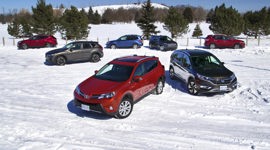Vehicle Type
Crossover SUV
CX-9 owners typically praise the model’s upscale cabin, commanding driving position, roominess and flexibility, and confidence in challenging driving conditions.
History/Description
Designed to cater to the needs of busy Canadian families after key Mazda attributes like upscale styling and fun-to-drive dynamics, the CX-9 is the largest vehicle in the Japanese automaker’s product lineup. A totally revised version of the Mazda CX-9, complete with all-new engine, All Wheel Drive (AWD) technology and styling is hitting the marketplace in 2016, meaning the first-generation CX-9 has now moved officially into used car territory.
Look for up to three seating rows, a generous cargo hold with the third row seats folded, and upscale feature content including HID lighting, a sunroof, Bose audio, automatic climate control, push-button start, wood trim, heated leather, a motorized tailgate and more, depending on the model selected. Cross-shopping exercises should include the Honda Pilot, Ford Explorer and Hyundai Santa Fe XL.
Engines/Trim
All CX-9 models came powered by a V6 engine displacing 3.5 or 3.7 L and making up to 273 hp. The smaller, 3.5L V6, with 263 hp was replaced by the larger 3.7L unit from 2008 and on. All models got an automatic six-speed transmission, and most used copies will feature Mazda’s Active Torque Split All Wheel Drive (AWD system). Look for GS and GT models as nicely-loaded and fully-loaded, with navigation and luxury packages available.
What Owners Like
CX-9 owners typically praise the model’s upscale cabin, commanding driving position, roominess and flexibility, and confidence in challenging driving conditions. The Bose stereo and xenon lights are among the favorite features, and styling is highly rated, too. Ditto, the performance from the punchy V6 engine. Third-row seating is also noted to be comfortable enough for use by smaller passengers.
What Owners Dislike
Common complaints include heavy fuel consumption, a navigation screen that’s hard to read in direct sunlight, and some low-budget interior trimmings.
Here’s a look some very positive owner reviews.
The Test Drive
Start with a full inspection of the CX-9’s exterior and body for signs of excessive wear and damage to paint, trim and the like. Common areas for rust and wear include the front edge of the hood, the lower, inner edge of the tailgate, and the lower edges of the doors. If wear and tear seems excessive given the year and mileage, call it into pricing negotiations. Check the wheels and tires for signs of excessive wear and damage, too.
Some owners have reported failure of the CX-9’s All Wheel Drive (AWD) system hardware, at low mileage, and typically under warranty. The problem seems to stem from a bad batch of Power Takeoff Units, or PTU’s installed at the factory. Here’s some more reading. Though this issue doesn’t seem widespread, CX-9 shoppers set on a model with AWD are advised to have a Mazda mechanic check all system electronics, to inspect the PTU assembly and rear differential for signs of fluid leakage, and to confirm that no ‘AWD’ warning lights are lit up in the instrument cluster. Where feasible, apply heavy throttle from a stop in snow or sand (or a similarly slippery surface) to coax the system to engage, confirming that no unwelcome noises or warning messages are present.
Confirm the steadiness of the CX-9’s idle, noting that a rough or sporadic idle may be evidence of a bad throttle-position sensor, or another sensor, which will need some attention. A full computer system scan takes minutes, and can reveal possible issues lying in wait with any of the CX-9’s engine management sensors.
Run the engine at idle with the hood open, and listen for a ticking sound from deep below the engine. Though inconclusive, this issue could be the result of a bad belt pulley that’s worn or wearing, or a more serious case of lifter-tick, which involves components inside of the engine. Here’s some more reading. In any case, if you notice any unwelcome ticking sounds from under the CX-9’s hood, be sure to have a mechanic investigate on a pre-purchase inspection. Note that according to the owners community, changing a water pump in a CX-9 involves engine removal.
Have a mechanic double-check for a leaky water pump, by finding any sign of coolant leaking from the weep-hole, which is designed to exhibit a leak when the water pump is on its way out. Allowing the water pump to fail outright can cause engine damage, and the mixing of engine coolant and oil, as the water pump is driven by the engine camshaft. This is a pricey job should repair be required, so be absolutely sure the water pump on the model you’re considering is in top shape and not leaking. A positive check for oil in the coolant, or coolant in the oil, may be another warning sign.
Other checks should include the xenon lighting system, all on-board electronics (especially the Bluetooth and navigation system), the climate control fan, confirming that all speed settings activate, and the sunroof, if equipped. Hesitation of the engine to start via the keyless switch or button may be the result of a dying battery in the keyfob. A suspension check, including a check of the condition of all bushings, is a good idea on higher-mileage units, too.
The Verdict
With a clean bill of health after an inspection of its cooling system, AWD system hardware and all on-board electronics, a used Mazda CX-9 should make an ideal family crossover for the shopper after sharp styling, upscale feature content and above-average attention to driving dynamics.
Some recalls.
Crash Test Ratings
IIHS: Ratings here
NHTSA: 4/5 stars

























